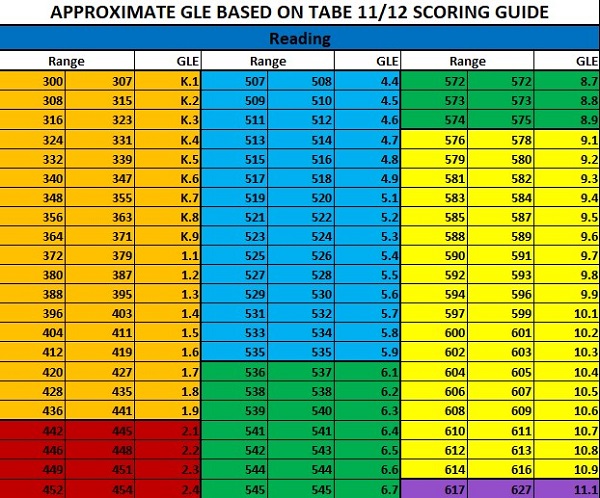- MN ABE Connect
- Archive
- Helpful Resources to Transition to TABE 11/12
 April 19, 2019
April 19, 2019
Helpful Resources to Transition to TABE 11/12
Kerin Hanson, ABE InstructorWe all know the age of the TABE 11/12 is fast approaching. The transition period from TABE 9/10 to TABE 11/12 is ending July 1, 2019. This means we, as teachers, need to be as prepared as possible to administer these new tests, as well as be able to analyze them.
DRC, the testing company that produced the TABE, has provided resources, including diagnostics, that can be purchased for the TABE. But the new diagnostic was lacking some key pieces, including tools we had before. So, I decided to take the time to create some resources for teachers in the field and data people in our consortia to make the transition easier and a lot more comfortable – at least for the math. The resources for ELA are being created by another teacher in my consortium, and will be available soon.
Characteristics of the new TABE 11/12
We have seen that TABE 11/12 is a very different test from the TABE 9/10. Among these differences are:
- the questions are more robust
- the reading tests are longer and more involved
- the math is mostly word problem based
- the answers can include more than one standard
We are also seeing changes in the types of questions and answers because the TABE was changed to fit the CCRS standards. The new test is asking the student to do more and have a higher depth of knowledge for the questions being asked.
The diagnostic that was provided by DRC takes into account this depth-of-knowledge issue by creating general groups of what the questions are addressing, instead of specifying a standard or mathematical concept. As a teacher in the field, I found this particular diagnostic was not very helpful. I needed a more specific look at what gaps my students might have in their education, or what concepts they did not understand or remember from their days in the K-12 system. I’m sure none of this is news to you either, but in any case, the new diagnostic just wasn’t useful to me.
New resource: diagnostic checklists
I needed a diagnostic that was organized, specific, and easy enough to read and glance through, so it couldn’t be 10 pages long per test. This is where the diagnostic/checklists I created comes into play. The standards that are listed come straight from the CCRS blue book and are either paraphrased to save space or copied word for word on the shorter ones. You will notice an asterisk next to some of the standards listed, which denotes that there are sub-standards under that category. It will be handy to have the blue book sitting next to you. This diagnostic feels more like the old one, and is more comfortable to use.

Each checklist created is specific to the CCRS level that matches with a particular TABE test. The checklist and diagnostic matches the questions from the TABE with specific CCRS Math Standards for that level. These pairings came from the DRC table that matches CCRS Levels to the TABE tests. I saw this table at the TABE 11/12 training I attended this Fall.
Some of the questions do address more than one CCRS standard, so you will want to continue looking through the document to make sure you didn’t miss a question number that may show up more than once. The other thing this checklist has that DRC’s does not, is the inclusion of the field test questions in the diagnostic. These questions are just as important to see what skills a student might be missing from the testing data, so they needed to be included as well.
Using the checklists with students
Now that we have all the fun parts out of the way, how am I using these checklists in my own classroom? The main reason I created these documents is to give myself a more detailed look into the gaps a student has in their math education. I needed something that gave me that in-depth view so that I could help students see what skills they need to work on. I use the checklist as a guide for the math PEPs for the students. They are also able to see what standards they need to learn and master before they can move on to higher level skills or be ready for GED testing. It also helps me see if I need to change test levels for a student once they have reached 40 hours of instructional time.
Our consortium is also part of the Adult Standard Diploma group, so I have been able to utilize these documents to determine when a student can move from one level to the next. It also helps provide evidence that a student has mastered all the Level D standards as well as show when they met and mastered the Level E standards. This is extremely helpful for students who wonder how long it’s going to take them and what they need to accomplish to complete their credential. I am also planning on using my original spreadsheet as a database of different curricula and resources that will address each particular standard.
New resource: GLE table
Another tool that I created was an Approximate Grade Level Equivalency table. For me, this was a crucial piece that was missing from the tools we were given by DRC. As a person who tests Work Force clients in my county, I have to provide a grade level equivalency for each client. I took the table DRC provided – with very broad categories of grade levels for a score set – and evenly distributed those scores amongst more specific grade levels. This gave me an idea of the equivalent grade and month of school for the clients and students.

These tools are available to you to use as I do, or to adapt them to your own situation. I saw a desire and need for a more useful diagnostic in the trainings, so I wanted to share these with my fellow teachers. I know other classrooms in our consortium and around the state are using them and find them extremely helpful.
More information
If you have questions about the resources or want to know more, feel free to email Kerin Hanson at [email protected] and I will help explain more about how we are using them as tools in our setting. Also, if you feel a change needs to be made or have ideas on how to make them more universally useful, I am more than happy to discuss that with you.
Access and download these documents >>
Originally published 2/25/19

Newsletter Signup
Get MN ABE Connect—the official source for ABE events, activities, and resources!
Sign UpArticle Categories
- ABE Foundations/Staff Onboarding
- ACES/Transitions
- Adult Career Pathways
- Assessment
- CCR Standards
- Citizenship
- COVID-19
- Cultural Competency
- Digital Literacy/Northstar
- Disabilities
- Distance Learning/Education
- ELA
- Equity/Inclusion
- ESL
- HSE/Adult Diploma
- Listening
- Math/Numeracy
- Mental Health
- Minnesota ABE
- One-Room Schoolhouse/Multilevel
- Professional Development
- Program Management
- Reading
- Remote Instruction
- Science
- Social Studies
- Speaking/Conversation
- Support Services
- Teaching Strategies
- Technology
- Uncategorized
- Volunteers/Tutors
- Writing